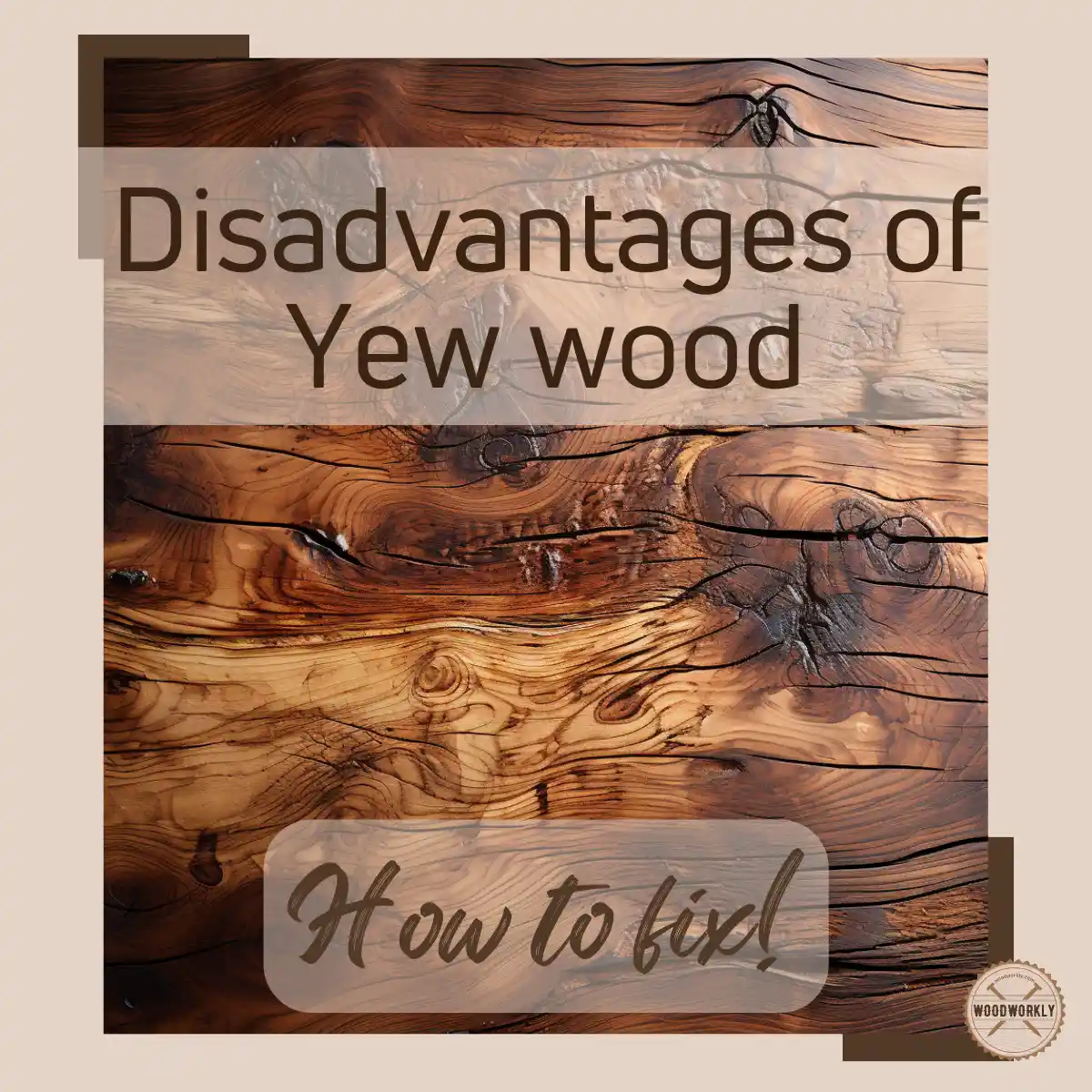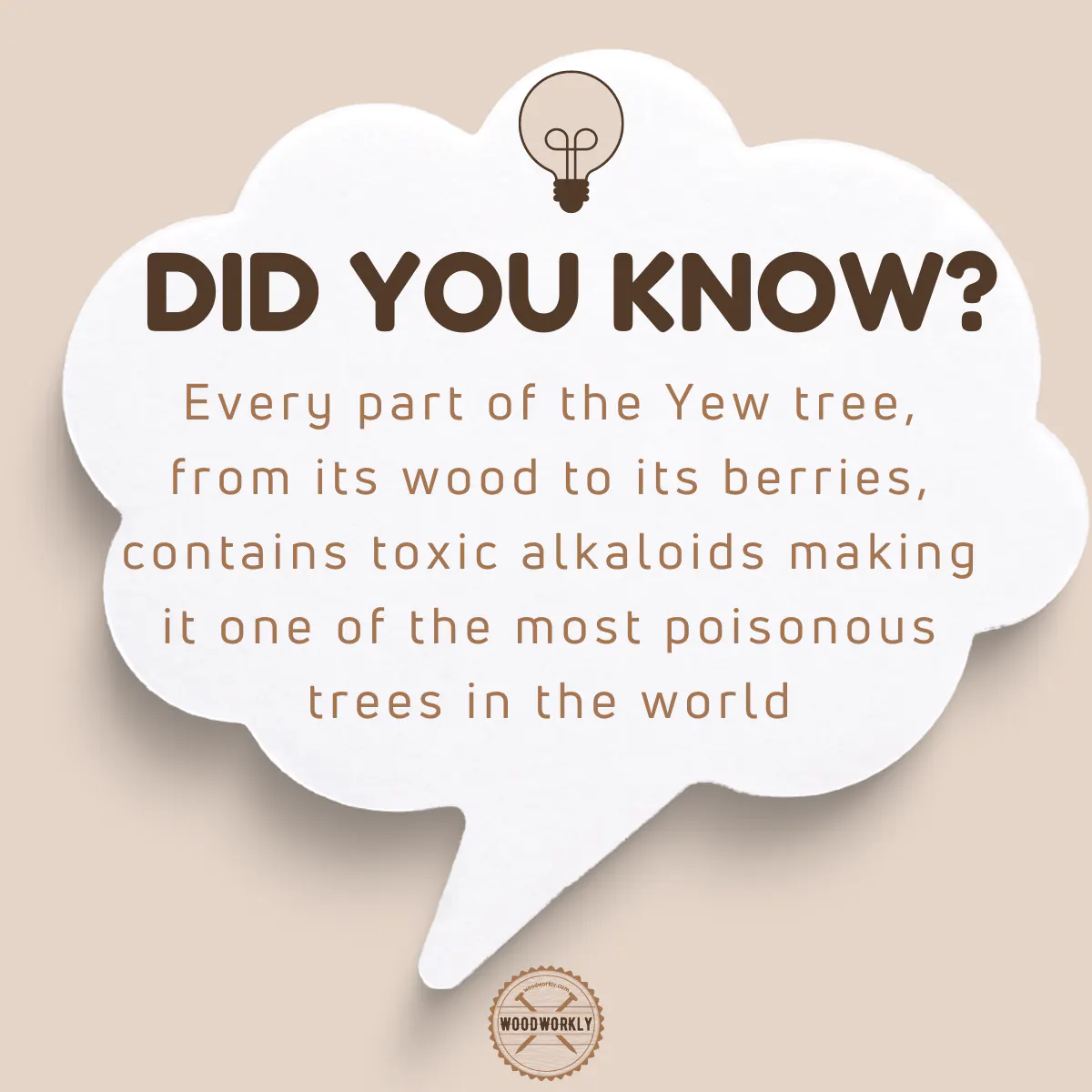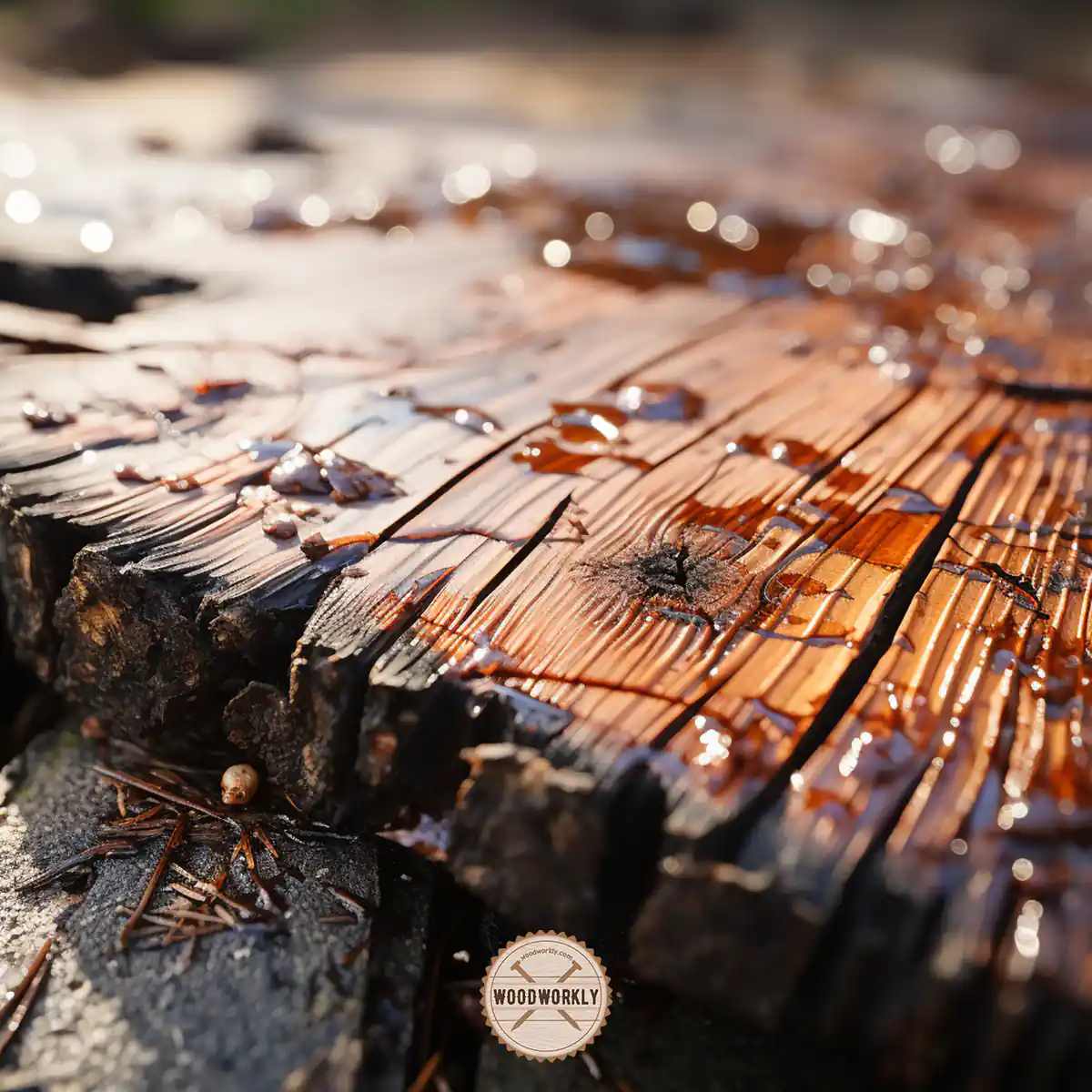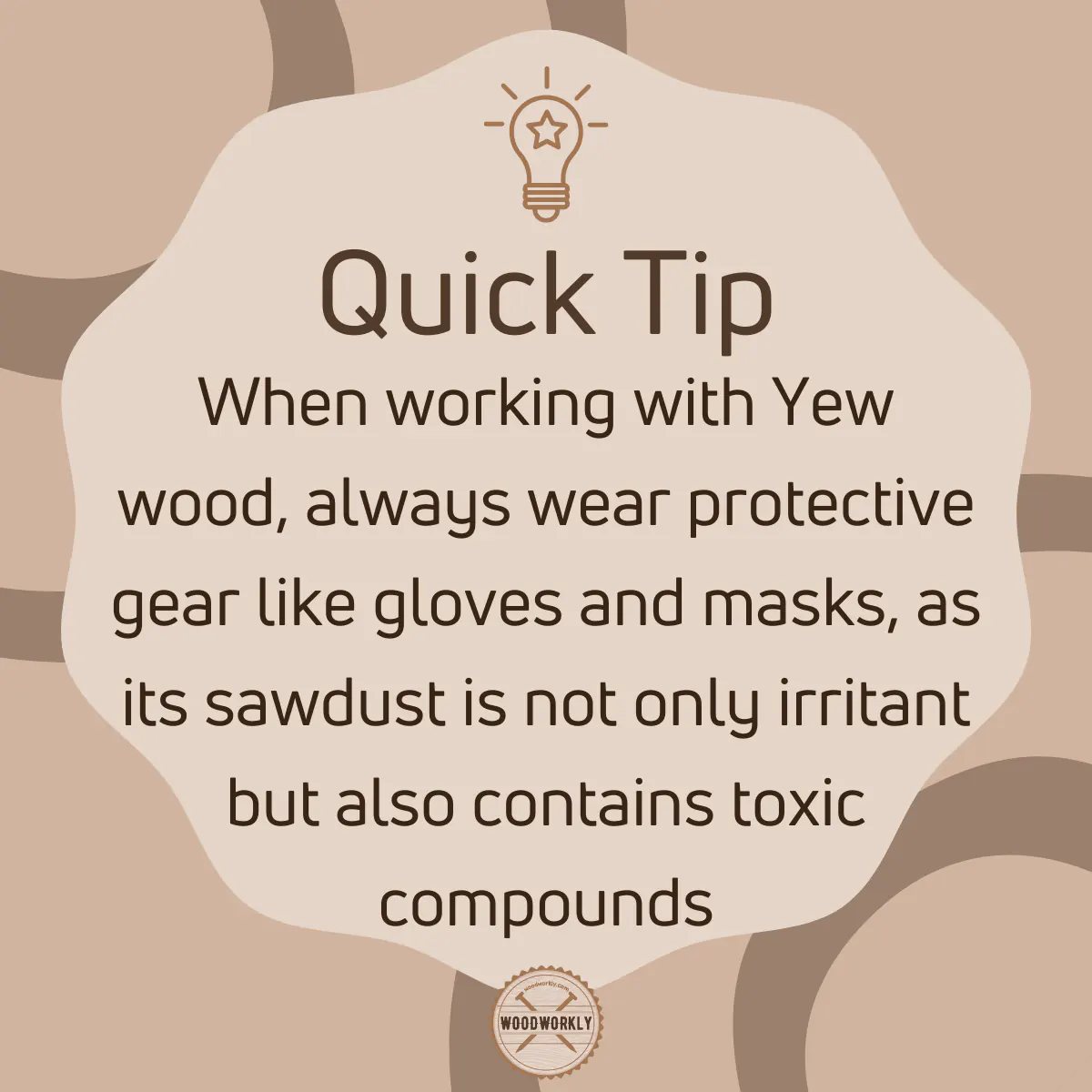Ever marveled at Yew wood’s beauty? But do you know its downsides? Dive in to uncover surprising facts!

Yew wood is a softwood that is distributed in North America, Europe, and Southwest Asia. It is widely used for wood carving projects, furniture making, musical instruments, and veneers.
It has lots of benefits that are very much important to any woodworker. But on the other hand, there are some cons as well.
I did some research to find out Yew wood disadvantages and found a lot with the help of the experts.
Here’s the list of disadvantages of Yew wood,
- Yew wood is difficult to finish
- Yew wood is irritant
- Expensive
- Yew wood is knotty
- Not food safe
- Darken with age
But there’s a lot more to know about those cons!

In this article, I will take a deep look at each of the above disadvantages of Yew wood in detail and find out the best methods possible to fix them and get a good outcome from the wood.
Furthermore, I’ll answer some frequently asked questions as well.

So, as a fresh start, let’s have a brief look at some main advantages of Yew wood to see why it has become so popular.
Advantages Of Yew Wood
- Extremely hard
- High flexibility
- High durability
- Yew wood is easy to work with
- Rot-resistant
- Excellent water resistance
- Attractive orange-brown appearance
- Straight grain with natural luster
- No characteristic odor
As you can see Yew wood is one of the few kinds of wood that have everything, we need from some wood.
Yew wood is filled with lots of benefits which is used literally for any project with ease.
But every silver lining got its touch of grey. There’re some drawbacks of Yew wood as well.

So, let’s talk about the disadvantages of Yew wood with fixes.
Disadvantages Of Yew Wood
So, let’s talk about the drawbacks of yew wood in detail and how to fix them.
1. Difficult To Finish
Yew wood contains a lot of oil inside. Because of that finishing Yew wood with an oil finisher or any other finisher can be so difficult.
Wood finishers may face difficulties to penetrate the inside of the Yew wood and spreading evenly.
Because of its poor staining and finishing properties, there’s a high possibility of making wood stain mistakes, and polyurethane mistakes and ending up with blotchy or tacky surfaces.
Wood stain and other finishers love when the wood is dry with a minimum number of oils and moisture inside.
Yew wood’s high oil content makes it so hard to stain and finish and there’s a high chance of ending up with a bad stain job.
Therefore, making a protective coating over Yew wood is hard and Yew wood furniture and other woodwork may get easily damaged due to environmental elements such as moisture, UV light, and insect attacks.
Plus, when you want to turn Yew wood into another preferred color without losing its grain texture you probably go for staining.
But in this case, staining Yew wood can be difficult because of its high oil content, and turning wood into your preferred color will not be possible.
Because of being difficult to stain especially with oil finishes like Tung oil, and Danish oil, you better finish Yew wood with varnish, lacquer, or paint. Those finishes work really well with Yew wood and are able to give a protective coating with an enhanced wood appearance.
In summary, here’re the best finishes for Yew wood,
- Shellac
- Wax
- Lacquer
- Varnish
- Paint

2. Irritant
The Yew tree is known as one of the most poisonous trees in the world. Leaves, wood, Yew berries, needles, bark, and all other parts of the Yew tree are highly poisonous to humans and other animals.
Therefore, you should really careful when working with Yew wood.
Yew wood contains taxine, which is a toxic alkaloid.
Yew sawdust can be extremely poisonous for many people which can cause breathing issues, asthma, sneezing dermatitis, and fits. Therefore always wear gloves when working with Yew wood.
Plus, Yew wood sawdust can cause eye and skin allergies as well.
Headache, nausea, and cardiac effects are the most common conditions that can happen when working with Yew wood without any safe.
Wood dust from any wood can cause breathing issues, but in this case, Yew wood contains toxic compounds that can do more severe damage than other woods.
In order to get the benefit from Yew wood, while keeping safe, always wear, goggles, a face mask, latex gloves, and a woodworking apron when working with Yew wood.
Plus, make sure to open all the windows when sanding or doing any other woodworking activity with Yew wood because good air circulation prevents sawdust from depositing on our skin.
Plus, use a proper dust collection pipe system to quickly remove Yew sawdust when working.
By following all the precautions as discussed, you’re ok with it. Don’t let toxic sawdust of Yew wood go into your respiratory system.

3. Expensive
Yew wood is priced more than regular wood with similar properties because it is so hard to find.
Yew wood has high waste factor than most other woods because some trunks have lots of knots and bad areas for woodworking.
Because of that Yew wood is more expensive than other woods.
Most Yew trees are hollow from the inside and lumped in the lumber.
Therefore, you need to cut a lot of Yew trees for specific woodworking projects than other trees. Plus, the wood is rare and the price is high.
If you’re on a budget, better to go for Oak, Mahogany, and cedar which have similar properties to Yew wood and also, they are readily available in many stores.

4. Yew Wood Is Knotty
Yew wood has lots of visible knots. Having knots is not good for woodworking because knotty areas are hard to cut, screw, and nail and those areas act differently than other areas of the wood. Plus, those areas are hard to stain and finish.
Knots in Yew wood are imperfections that naturally occur because of the deviations in the wood grain to accommodate wood inside the branches of the Yew tree.
Knots are left behind after branches are cut off.
Knotty Yew wood is not durable, and rot-resistant as regular Yew wood.
They have an uneven appearance which doesn’t give a pleasing appearance to woodwork.
Always check your Yew wood well before purchase to avoid knotty wood since working with knotty wood is extremely difficult.
But there’re some people who love the knotty surface of Yew wood because of its uniqueness.
Knotty Yew wood is mostly used for decorative purposes, flooring, bow making, and many more.
If you mainly focus on durability, strength, and workability, better to go for Yew wood with less or without knotty since they have excellent properties with a uniform texture.

5. Yew Wood Is Not Food Safe
Yew wood is not food safe because it contains toxic alkaloids caused by taxine. Therefore, never use Yew wood for kitchen utensils, bowls, cutting boards, chopping boards, and kitchen countertops.
Yew wood is poisonous and ever never use for any woodworking project that touches food.
Every part of Yew wood is toxic and poisonous. Better to go for food-safe wood when making kitchen utensils and cutting boards such as Maple, Birch, and Beech.
Plus, never use Yew wood for children’s toys because toxins can leech out pretty quickly and damage the user.

6. Yew Wood Darken With Age
Yew wood darkens with age because of sunlight, natural aging properties, environmental elements, and more reasons.
The warm orange color of Yew wood turns into dark orange over time which is a bad thing if you considered wood color over its mechanical properties when purchasing.
The darkening process of Yew wood accelerates when the wood is exposed to UV light in direct sunlight.
UV light not only darkens the wood but also causes wood cracks and ruins the wood’s appearance.
Most outdoor Yew wood furniture and woodworks tend to darken pretty quickly than indoor furniture because they are directly exposed to most of the factors that cause wood darkening like sunlight.
To protect Yew wood from darkening, better to finish wood with a proper sealer or finisher that contains UV inhibitors.
UV inhibitors absorb UV light from direct sunlight and dissipate it as thermal energy.
Wood finishers prevent UV light from hitting the Yew wood surface and slow down the darkening process.
Plus, you can keep Yew wood furniture away from direct sunlight or cover them up to prevent the wood from darkening.
This is a natural process hard to avoid completely, but you can slow it down by finishing wood and protecting Yew wood from environmental elements.

That’s it, folks! Now you have a clear idea about the disadvantages of Yew wood with all the fixes which are so important when using Yew wood for your future projects.
Is Yew Wood Poisonous?
Yes, wood is poisonous because it contains toxic alkaloids caused by taxine. Therefore, breathing Yew wood sawdust and using Yew wood for cutting boards can be extremely poisonous.
Make sure to wear a face mask, goggles, and latex gloves when working with Yew wood to keep you safe.
Yew wood is an irritant for the skin and eyes and it can damage the respiratory system.
Make sure to do the woodworking with Yew wood in a well-ventilated area or use a proper dust collection system to remove sawdust without letting them touch or deposit on your skin which can cause allergy issues.

Is Yew Wood Good for Anything?
Yew wood can use for any woodworking, wood carving, or construction project except food applications.
It has excellent strength, durability, and weather resistance and is able to tolerate harsh temperature levels without losing its strength.
Yew wood is good for both indoor and outdoor woodworking projects because it has good resistance to insect and bug attacks as well.
Here’re some popular uses of Yew wood,
- Flooring
- Boat building
- Wood carving
- Musical instrument making
- Furniture making
- Veneers

Can Yew Wood Be Painted?
Yes, Yew wood is easy to paint since it takes paint so well. Apply primer before painting Yew wood for even application.
You can give Yew wood any color you want but it favors dark colors because Yew wood tends to get dark with age.
How To Identify Yew Wood?
You can identify Yew with its needle-like leaves that grow in two rows, and it has red berry-like arils.
Plus, its sapwood has a thin band of pale-yellow color. Wood has a light orange color that eventually turns dark with age.
Yew tree is considered one of the hardest woods among softwood trees because of its excellent durability, hardness, and density compared to other conifer softwood species.

So, let’s answer some frequently asked questions.
FAQs
Why is Yew wood difficult to finish?
Yew wood contains high oil content, which can make finishing challenging. Using oil finishes might result in blotchy or tacky surfaces, hence alternative finishes like varnish, lacquer, or paint are often recommended.
Is Yew wood dangerous to work with?
Yes, Yew wood can be harmful due to the presence of taxine, a toxic alkaloid. Exposure to Yew sawdust might lead to breathing issues, skin allergies, and other health concerns, so proper safety gear is crucial.
What are the challenges posed by knots in Yew wood?
Knots in Yew wood can make it hard to cut, screw, and nail. These knotty areas are often less durable and rot-resistant than other sections and can be challenging to finish uniformly.
Is Yew wood safe for kitchen use?
No, Yew wood is not food-safe due to its toxic alkaloids. It’s advisable to avoid using Yew for kitchen utensils, cutting boards, and other food-related items.
How does Yew wood’s appearance change over time?
Yew wood darkens with age, especially when exposed to sunlight. This natural aging process can accelerate with direct UV exposure, which can also cause the wood to crack.
Can Yew wood be painted?
Yes, Yew wood can be painted effectively, especially when a primer is applied first. However, dark colors are often preferred as the wood naturally darkens over time.
How can one identify Yew wood?
Yew wood typically exhibits a light orange hue that darkens with age, has needle-like leaves growing in two rows, and features red berry-like arils.
Did I cover all you wanted to know about: Disadvantages Of Yew Wood?
In this article, I have widely discussed disadvantages of Yew wood in detail. Plus, we have discussed some fixes to overcome those disadvantages and get the best out of them.
Disadvantages of Yew wood include its high cost due to rarity, challenges in finishing because of its oil content, potential health risks from toxic taxine when working with it, knottiness causing durability issues, and its unsuitability for kitchen or food-related uses.
Furthermore, I’ve answered some frequently asked questions as well.
Hope you have gained good knowledge about the disadvantages of Yew wood in-depth.
Try to use Yew wood for your next woodworking project and see how the wood behaves and how to fix its common drawbacks with the help of this article. Happy woodworking!